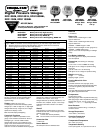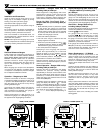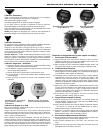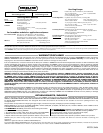
Calibration Precautions
Install or remove gauge using wrench on hex fitting only. Do not attempt to
tighten by turning housing or any other part of the gauge.
See label on back of gauge for range!
Use fittings appropriate for the pressure range of the gauge.
Do not apply vacuum to gauges not specified for vacuum operation.
Permanent damage not covered by warranty will result to the sensor.
Due to the hardness of 316 stainless steel, it is recommended that a thread
sealant be used to ensure leak-free operation.
NEVER insert objects into the gauge port or blow out with compressed air.
Permanent damage not covered by warranty will result to the sensor.
Calibration Information
All gauges are factory calibrated on NIST traceable calibration equipment.
No calibration is required before placing the gauge into service.
Gauges can be returned to Omega Engineering for factory certified
recalibration. NIST traceability is available. Gauges can also be recalibrated
by any metrology lab with pressure calibration equipment at least four times
more accurate than the gauge.
Absolute Reference – These models display atmospheric pressure if the
gauge port is open to the ambient. It is normal for the reading to constantly
change in response to atmospheric pressure changes. Vacuum generation
and atmospheric pressure measurement equipment for accurate calibration
and thus these are more difficult to calibrate in the field.
Calibration Preparation – All Models
a. Calibration should only be performed by qualified individuals using
appropriate calibration standards and procedures.
b. The calibration equipment should be at least four times more accurate
than the gauge being calibrated.
c. Remove the screws on the back of the unit and remove cover.
d. It is good practice to install fresh batteries before calibrating battery-
powered gauges.
e. Allow the gauge to equalize to normal room temperature before
calibration.
Calibration of Ranges up to 1999
Remove the calibration potentiometer covers on the front of the unit to
access the zero and span controls.
Gauge reference units may be re-zeroed without affecting the span
calibration. The gauge port must be open to the ambient with no pressure or
vacuum applied. Adjust the Zero control until the gauge reads zero with the
minus (–) sign occasionally flashing.
Span calibration should only be attempted if the user has access to a
pressure reference of known accuracy. The quality of the calibration is only
as good as the accuracy of the calibration equipment and ideally should be
at least four times the gauge accuracy. Zero calibration must be done before
span calibration. Record readings at three to five points over the range of
gauge and adjust span control to minimize error and meet specifications.
Calibration of Ranges 2000 and up (with 4-digit 2-line display)
1. Entering the Calibration Mode
a. Remove the back cover and note the locations of the two internal
calibration pushbuttons marked UP and DOWN. These buttons are
disabled unless the gauge is in calibration mode.
b. With the gauge off, press and hold the DOWN calibration button, and
also press the front button to power up the gauge in calibration mode.
2. Calibration Mode Functions
a. The display first indicates the gauge’s full-scale pressure range, tests all
display segments, and then indicates CAL to indicate that the gauge is
in the calibration mode.Release all pushbuttons.
b. The display will then indicate the current pressure reading, updating
approximately 3 times per second. The gauge will remain in the
calibration mode until powered down or reset manually. While in the
calibration mode, the shutoff timer, One Touch Zero (gauge reference
models only), Min/Max (for applicable models) are all disabled, and the
calibration pushbuttons are active.
c. Each press of the UP or DOWN button makes a small correction, which
may not always be indicated on the digital display. Press and hold the
pushbutton for one second or longer to make larger continuous
corrections. The display of the gauge being calibrated is adjusted to
match the calibrator’s setting or readout.
d. If the battery pack is unplugged or the power removed during
calibration, calibration settings will not be saved.
3. Gauge Reference Gauges (3 Points)
a. With the gauge port open to atmosphere, the character display will
alternate between ZERO and CAL. Press the UP and DOWN buttons
to obtain a display indication of zero.
b. Apply full-scale pressure. The character display will alternate between
+SPAN and CAL. Press the UP and DOWN buttons to obtain a
display indication equal to full-scale pressure.
c. Apply 50% of full-scale pressure. The character display will alternate
between +MID and CAL. Press the UP and DOWN buttons to obtain a
display indication equal to 50% of full-scale pressure.
4. Exit Calibration Mode and Verify Calibration
a. Exit the calibration mode and save the calibration data by pressing and
holding the front button until the display indicates OFF.
b. Verify pressure indications at 0%, 25%, 50%, 75%, and 100% of full
scale.
c. Replace the rear cover and screws, taking care not to pinch the power
leads between the case and the rear cover.
DPG1000B, DPG1001B, DPG1000BBL, DPG1100B, DPG1100BBL
3
CAUTION:
NOTE:
DOWN UP
DPG1000, DPG1001 - Pull out plastic
plugs to access zero and span
potentiometers
DPG1100 - Unscrew nylon screws to
access zero and span potentiometers
DPG1000B, DPG1001B, DPG1000BBL
Ranges 2000 and up
DPG1100B, DPG1100BBL
Ranges 2000 and up






